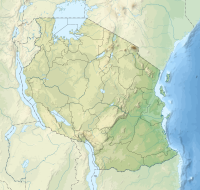Mbudya Island
| Mbudya Island | |
|---|---|
 Mbudya Island beach | |
| Location | Dar es Salaam Region, Kinondoni District |
| Nearest city | Dar es Salaam |
| Coordinates | 6°39′S39°14′E/ 6.65°S 39.24°E |
| Area | 14.2km² |
| Established | 1975 |
| Governing body | Marine Parks & Reserves Authority (Tanzania) |
| Website | DMRS |
Mbudya Island(Kisiwa cha Mbudya,inSwahili) is a protected, uninhabited island under theDar es Salaam Marine Reservewith theIUCN category IIlocated withinKinondoni DistrictofDar es Salaam RegioninTanzania.The island reserve measures around 14.2 km2.Fungu Yasinis to the north of the island, andBongoyo Islandis to the south. The island ofPangaviniis to the west.[1][2]The island is home to endangeredcoconunt crabs.[3]
Endemism
[edit]The island is home to theMetacirolana mbudya,an endemic species ofcirolanidaethat has only been found to live in the waters surrounding Mbudya island. It was first discovered in 1981.[4]
Access and recreation
[edit]A 20-minute speedboat journey from the mainland will get you to the island, which is near the beach resort and fishing village of Kunduchi. As a result, it is a well-liked day trip for both visitors and Tanzanian citizens, offering a variety of recreational opportunities, such as snorkelling, trekking, and sunbathing.[5]
See also
[edit]References
[edit]- ^"Marine Parks and Marine Reserves of Tanzania".Retrieved2020-09-07.
- ^Levine, Arielle. (2010). Local Responses to Marine Conservation in Zanzibar, Tanzania. Journal of International Wildlife Law and Policy. July–December 2004. 183-202. 10.1080/13880290490883241
- ^Caro, Tim, et al. "A case study of the coconut crab Birgus latro on Zanzibar highlights global threats and conservation solutions." Oryx 55.4 (2021): 556-563.
- ^Bruce, Niel L. “New Records of Cirolanidae (Crustacea: Isopoda) from the Tanzanian Coast of East Africa.” Journal of Crustacean Biology, vol. 1, no. 3, 1981, pp. 457–60. JSTOR,https://doi.org/10.2307/1547976.Accessed 7 Sept. 2023.
- ^"Dar Es Salaam Marine Reserves System".Retrieved19 May2023.

